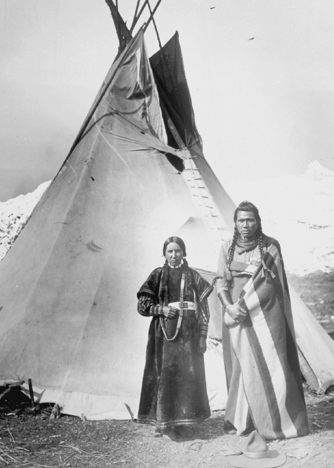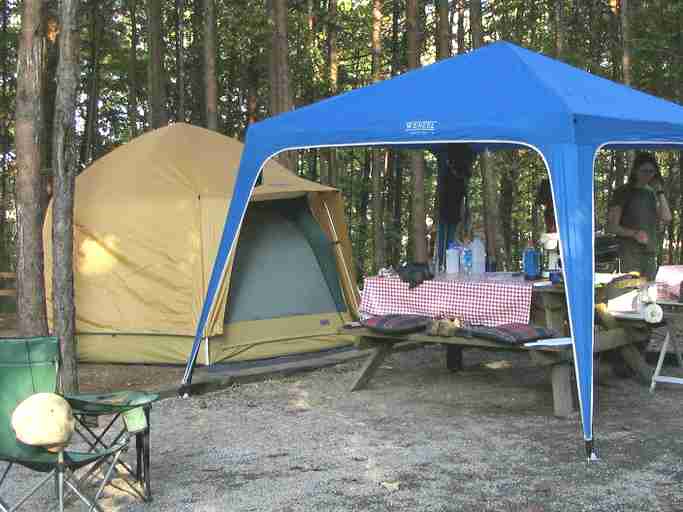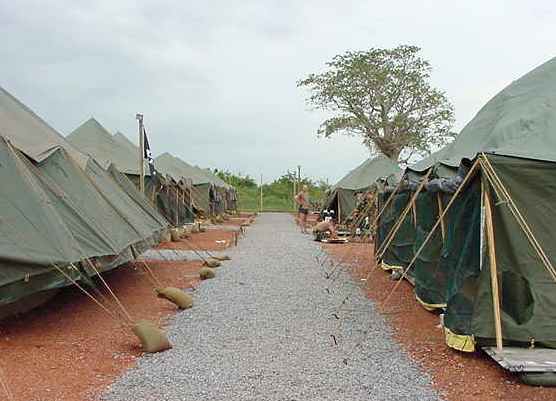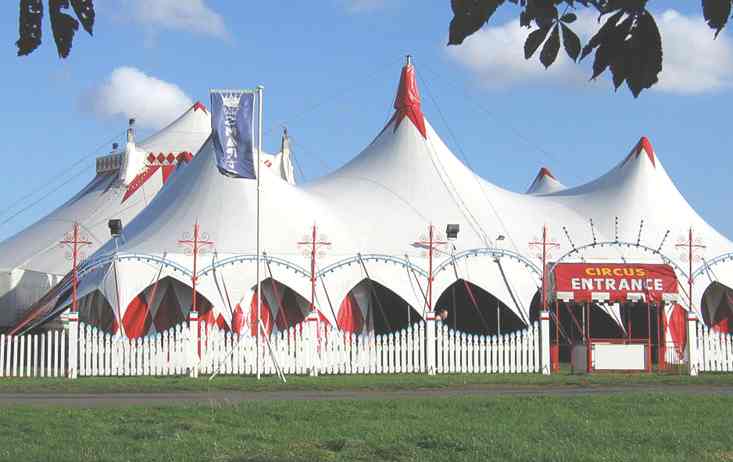|
A
tent is a shelter, consisting of sheets of fabric or other
material draped over or attached to a frame of poles and/or ropes. Some
tent styles are free-standing, while others are attached to the ground
using guy ropes tied to stakes (pegs). Tents were first used as portable
homes by nomadic peoples, but today, their main application is for
recreational camping. Modern tents are usually made of fire-retardant
material.

A
tent from Boulanger's painting C'est Un Emir
Tents
range in size from those barely large enough for one person to sleep in
up to huge (circus) tents capable of seating thousands of people. The
bulk of this article is concerned with recreational camping using tents
capable of sleeping from 1 up to about 10 people. Larger tents are
discussed in a separate section below.
Tents
for recreational camping are generally transportable by car. Depending
on tent size and the experience of the person or people involved, such
tents can usually be assembled (pitched) in between 5 and 25 minutes;
disassembly (striking) takes a similar length of time (some very
specialised tents have spring-loaded poles and can be 'pitched' in 2
seconds, but take somewhat longer to strike). Smaller tents may be
sufficiently light that they can be carried for long distances on a
person's back, or on a touring bicycle, a boat, or even a pack animal.
General
considerations
Tent
fabric may be made of many materials including cotton (canvas), nylon,
and polyester. Cotton absorbs water, so it can become very heavy when
wet, but the associated swelling tends to block any minute holes so that
wet cotton may be more waterproof than dry cotton. Nylon and polyester
are much lighter than cotton and do not absorb much water; with suitable
coatings they can be very waterproof, but they may deteriorate more over
time due to a slow chemical breakdown caused by ultra-violet light found
in sunlight. Since stitching makes tiny holes in a fabric, it is
important that any seams are sealed or taped to block up these holes.
Rain
resistance is measured as a hydrostatic head in millimetres (mm). This
indicates the pressure of water needed to penetrate a fabric. Heavy or
wind-driven rain has a higher pressure than light rain. Standing on a
groundsheet increases the pressure on any water underneath. Fabric with
a hydrostatic head of 1000 mm or less is best regarded as shower
resistant, with 1500 mm being usually suitable for summer camping. Tents
for year round use generally have at least 2000 mm; expedition tents
intended for extreme conditions are often rated at 3000 mm. Where
quoted, groundsheets may be 5000 mm or more.
Many
tent manufacturers indicate capacity by such phrases as "3
berth" or "2 person". These numbers indicate how many
people the manufacturer thinks can be crammed snugly into a tent in
sleeping bags without any allowance for personal belongings, luggage,
inflatable mattresses, camp beds, cots, etc. Experience indicates that
camping may be more comfortable if the actual number of campers is 1 or
even 2 less than the manufacturer's suggestion.
Tents
can be improvised using waterproof fabric, string, and sticks. This
allows them to be easily built and moved.
Parts
of a modern tent
-
-
When
a flysheet or outer tent is used, it is important that there be
no contact with the inner tent it is protecting; this keeps the
inner dry even if the outer is wet. Expedition tents often have
extra poles to help ensure that wind does not blow the two
layers into contact. The double layer may provide some
insulation.
-
A
groundsheet is used to provide a waterproof barrier between
the ground and a sleeping bag. With double skin tents, the inner
tents normally have a sewn-in groundsheet, but a separate flat
groundsheet may be provided for any living area. With single skin
tents, the groundsheet may be sewn in or separate. Normal practice
with sewn-in groundsheets is for the groundsheet to extend some 15
cm (6 in) up the lower part of the walls (sometimes called a
bath-tub arrangement); this copes with a situation where water seeps
under the side walls of the tent. Separate groundsheets allow
loadsharing when backpacking, and may make it easier to pitch and
strike a tent, but they provide less protection against insects etc.
getting into the sleeping area; also, if any part of a separate
groundsheet protudes from under the side walls, then it provides a
ready path for moisture to flow into the tent.
-
The
poles provide structural support. They may be collapsible for
easier transport and storage. Some designs use rigid poles,
typically made of metal, or sometimes wood.
Other designs use semirigid poles, typically made of fiberglass,
or sometimes of special metal alloys.

wooden
stake and guy rope supporting a tent
-
Stakes
or pegs may be used to fasten the tent to the ground. Some
are attached to guy ropes that pull outward on the poles
and/or fabric to help shape the tent or give it additional
stability. Others are used to anchor the bottom edge of the fabric
to the ground. Pegs may be made of wood, plastic, or metal. A mallet
may be needed to drive thicker pegs into the ground. Skewer
metal pegs consisting essentially of a length of thick wire with a
hook on one end can usually be inserted by hand, except if the
ground is very hard, but may not be as strong as more substantial
pegs. Pegs used for guy ropes should not be driven vertically into
the ground; instead for maximum strength they should be driven in at
an angle so that the peg is at right angles to the guy rope attached
to it. Lighter free standing tents may need some guy ropes and pegs
to prevent them from being blown away.
-
Multiple
air vents should be provided to help reduce the effects of
condensation. When people breathe, they expel quite a lot of water
vapour. If the outside of the tent is colder than the inside (the
usual case), then this vapour will condense on the inside of the
tent, on any clothing lying about, on the outside of a sleeping bag,
etc. so that everything is damp in the morning. Hence it is
important to have plenty of ventilation to help dispel the vapour
and get it outside the tent, even if this lets in cold air and makes
the tent feel a little cooler. Many inner tents are made of some
'breathable' material so that water vapour can more easily pass
through it.
-
An
optional tent footprint or groundsheet protector may
be used. This is a separate flat groundsheet which goes underneath
the main groundsheet, and is slightly smaller than that groundsheet.
The intention is to protect the main groundsheet, especially when
camping on rough terrain, since it is much cheaper to replace a
separate footprint groundsheet than it is to replace a sewn-in
groundsheet.

Nez
Perce tipi (teepee)
Design
factors
Many
factors affect tent design, including:
-
Financial
Cost.
-
Intended
use.
-
Backpacking/tramping,
having to carry the tent all day. Weight is the most crucial
factor, and packed size may also be significant.
-
Touring,
having to pitch and strike the tent every day or so. Ease of
pitching/striking the tent then becomes important.
-
Static,
staying at one campsite for a week or two at a time. A
comfortable camping experience is then the target.
-
A
tent required only for summer use may be very different from one to
be used in the depths of winter. Manufacturers may label tents as
one-season, two/three-season, four season, etc. A one-season tent is
generally for summer use only, and may only be capable of coping
with light showers. A three-season tent is for spring/summer/autumn
and should be capable of withstanding fairly heavy rain. A
four-season tent should be suitable for winter camping at low
altitudes; an expedition tent (for mountain conditions)
should be strong enough to cope with some snow as well as heavy
rain. Some tents are sold, quite cheaply, as festival tents;
these may be suitable only for camping in dry weather, and may not
even be showerproof.
-
Size
of tent.
-
The
number of people who will be camping determines how big the
sleeping area(s) must be.
-
To
allow for inclement weather, some covered living space may be
desirable. Alternatively, cyclists on a camping trip may wish
for enough covered space to keep their bicycles out of the
weather.
-
To
allow for sunshine, an awning to provide shade may not go amiss.
Some tents have additional poles so that the fabric doorways can
be used as awnings.
-
Internal
height. Manufacturers quote the maximum internal height, but the
usable internal height may be a little lower, depending on the
tent style: ridge tents have a steeply sloping roof so the whole
height is rarely usable, dome tents slope gently in all
directions from the peak so something close to the whole height
is usable in the centre, tunnel tents have a good usable height
along the center line. Frame and cabin tents have gently sloping
roofs and near vertical walls, so both the wall height and the
maximum height must be considered.
-
-
Height
is significant in connection with moving around in a sizable
tent, and in changing clothing in any tent. There are basically
four useful heights to consider: lie down only, sit, kneel,
stand. The exact heights at whch these apply depend on the
heights of the campers involved; those over 182 cm (6 ft) are
likely to have less choice of tents than those who are somewhat
shorter. As a starting point, sitting height is often between 90
and 105 cm (3 ft to 3 ft 6 in), and kneeling height may be
between 120 and 150 cm (4 ft to 5 ft).
-
-
Larger
tents sometimes are partitioned into separate sleeping areas. A tent
described as viz-a-viz usually has two separate sleeping
areas with a living area in between.
-
In
some areas of some countries (e.g. Lake District in England),
there may be restrictions as to what colour tents can be, so as to
reduce the visual impact of campsites in an area of great natural
beauty. Green or brown is generally acceptable.
-
Some
styles of camping and living outdoors entails quick setup of tents.
As a general rule, the more robust the tent, the more time and
effort needed to setup and dismantle.

Large
family tent for car-camping, with a gazebo
Shelters
Shelters
are not normally used for sleeping. Instead they may act as a store or
provide shelter from sun, rain, or dew.
-
A
flysheet consists of a single rectangular sheet of material.
Two opposite sides are held up in the middle by poles, or sometimes
just a rope between conveniently placed trees. The tops of the poles
are attached via guy ropes to pegs, in order to keep the poles
upright. Additional guy ropes are attached to the lower edges to
pull them outwards away from the poles.
-
A
gazebo uses a framework of metal poles to support a roof.
This structure provides a lot more usable space than does a
flysheet, since the gently sloping roof allows for a reasonable
amount of headroom even at the edges (like a frame tent). Because a
gazebo is free-standing, it is often used as a shelter for a
temporary shop at a fair or street market.
-
Beach
tents are often a simplified form of dome tent and provide a
useful (relatively sand-free) place to temporarily store beach
equipment, but are at most showerproof. Some beach tents use
specially treated fabric which is opaque to ultra-violet light, and
so provide some protection against sunburn. Maximum height is
typically about 120 cm (4 ft), and they are usually not large enough
for an adult to lie down in.
Current
tent styles
With
modern materials, tent manufacturers have great freedom to vary types
and styles and shapes of tents.
-
The
poles effectively hold the tent in the required shape.
-
Poles
which dismantle for ease of transport are either colour-coded or
linked by chain or cord, so there is little doubt as to which poles
connect where.
-
Relatively
few guy ropes are needed (sometimes none).
-
The
exact positioning of any guy ropes is not too critical.
Rigid
poles
Many
tents which use rigid steel poles are free-standing and do not require
guy ropes, though they may require pegs around the bottom edge of the
fabric. These tents are usually so heavy (25 to 80 Kg) that it takes a
rather strong wind to blow them away.
-
Frame
tents are double-skin tents. They have a living area and one or more
nylon/polyester inner tents. The outer tent is draped over a
free-standing steel frame, and may be made of canvas or polyester
(the latter often has a hydrostatic head of 3000mm, i.e. three
season camping). The living area is generally at least as large as
the sleeping area, and there may be a specific section with window
and extra air vents for use as a kitchen. The walls are nearly
vertical and are typically about 150 to 180 cm high (5 ft to 6 ft).
The center of the gently sloping roof is often 210 cm (7 ft) high or
more and provides reasonable headroom throughout. The smaller
2-person models were less than 3 metres square (10 ft), but these
have largely been replaced by dome or tunnel tents. The larger
8-person models may exceed 5 metres (16 ft) in length and/or width.
-
Cabin
tents are single-skin tents used mainly in the USA. They often have
nylon walls, polyester roof, and a polyethylene floor, plus an
awning at one or both ends. With a hydrostatic head of only 1000 mm,
they may best be considered as summer tents. Removable internal
dividers allow the cabin to be split into 'rooms'. Sizes may range
from 13 ft by 8 ft (2 rooms) up to 25 ft by 10 ft (4 rooms), with
wall and roof heights similar to those of frame tents. There are
three separate pole units, with each unit consisting of two uprights
and a connecting ridge. These pole units support the centre and ends
of the roof, and are usually outside the tent.
Flexible
poles
Flexible
poles used for tents in this section are typically between 3 and 6
metres long (10 and 20 feet) and are normally made of tubes of
fibreglass with an external diameter less than 1 cm (1/3 inch). For ease
of transportation, these poles are made in sections some 30 cm to 60 cm
long (1 to 2 ft), with one end of each section having a socket into
which the next section can fit. For ease of assembly, the sections for
each pole are often connected by an internal cord running the entire
length of the pole.
-
Dome
tents have a very simple structure and are available in a wide
variety of sizes ranging from lightweight 2-person tents with
limited headroom up to 6 or 9-person tents with headroom exceeding
180 cm (6 ft). These may be single-skin, or single-skin with partial
flysheet, or double skin. Depending on the pole arrangement, some
models pitch outer-tent first, while others pitch inner-tent first.
The former helps keep the inner tent dry, but the latter may be
easier to pitch.
-
The
basic dome has a rectangular floor and two poles which cross at the
peak; each pole runs in a smooth curve from one bottom corner, up to
the peak, and then down to the diagonally opposite bottom corner.
There are usually special fittings at each corner which fit into
sockets at the ends of each pole - pole tension keeps everything in
shape. The poles usually run outside the tent fabric, which is
attached to the poles by sleeves, and sometimes also clips. Dome
tents do not require guy ropes and pegs for structural integrity,
but must be pegged down in high winds.
-
The
basic dome design has been modified extensively, producing tents
with three poles, tents with irregularly-shaped bases, and other
unusual types. A common variation is to add a third pole going from
corner to corner on one side; this is angled away from the tent, and
supports an extended flysheet or outer tent to give a porch/storage
area.

Tunnel
tent, Scotland
-
Tunnel
tents may offer more usable internal space than a dome tent with the
same ground area, but almost always need guy ropes and pegs to stay
upright. These are almost always double skin tents. Sizes range from
1-person tents with very limited headroom up to 8 or 10-person tents
with headroom exceeding 180 cm (6 ft).
-
A
basic tunnel tent uses three flexible poles, arranged as three
parallel hoops, with tent fabric attached to form a tunnel. The most
common designs have a sleeping area at one end and a
porch/storage/living area at the other. Smaller designs may use only
2 poles and larger designs may use 4 poles; the latter may have a
sleeping area at each end and a living area in the middle.
-
Hybrid
dome/tunnel tents are now common. One variation is to use a
basic dome as the sleeping area; one or two hooped poles to one side
are linked by a tunnel to the dome to provide a porch. Another
variation is to use a large dome as the living area, with up to 4
tunnel extensions to provide sleeping areas.

Military
tents in row formation
Older
tent styles
Most
of these tent styles are no longer generally available. Most of these
are single-skin designs, with optional fly sheets for the ridge tents.
All
the tents listed here had a canvas fabric and used a substantial number
of guy ropes (8 to 18). The guys had to be positioned and tensioned
fairly precisely in order to pitch the tent correctly, so some training
and experience were needed. This made these styles relatively unsuitable
for casual or occasional campers. Pup tents might use wooden or metal
poles, but all the other styles mentioned here used wooden poles.
-
A
pup tent is a small version of a ridge tent intended for 2 or
3 people. It usually has a rectangular floor of size ranging from 4
ft by 6 ft up to 6 ft by 8 ft, and ridge heights ranging from 3 ft
up to 5 ft. The side walls are usually about 1 ft high. There are
guy ropes for each pole, at each corner, and in the centre of each
side, and these guy ropes help to maintain the required shape.
Earlier versions had a single upright pole at each end, while later
versions often have two poles at each end, arranged rather like an
'A' shape, in order to make access easier. Some models have a
horizontal ridge pole joining the tops of the end poles to support
the centre of the tent.
-
A
ridge tent can sleep 5 to 8 people. They usually have a
rectangular floor of size ranging from 8 ft by 10 ft up to 10 ft by
16 ft, and ridge heights around 6 ft to 7 ft. The side walls are
usually about 3 ft high. They normally have a single upright pole at
each end with the tops joined by a horizontal ridge pole. Longer
models might have an additional upright pole in the centre to help
support the ridge pole. They often have two guy ropes at each
corner, and guy ropes every 2 ft along the sides. If strong winds
are expected then two additional storm guy ropes are attached to the
top of each pole.
-
A
square centre-pole tent was often used for family camping in
the first half of the 20th century. Despite the use of 9 poles and
12 guy ropes, such a tent could be pitched by an (experienced)
family of four in some 10 to 15 minutes. These tents had a square
floor of size ranging from 8 by 8 ft up to 15 by 15 ft. There were
poles about 5 ft high at each corner and in the middle of each side,
and a 10 ft or 12 ft pole in the centre - the walls were vertical
and the roof was pyramid-shaped, so there was plenty of headroom
over most of the tent.
-
A
Sibley tent (bell tent) had a circular floor plan some 10 ft
to 15 ft across, a single central pole some 10 ft high, and walls
about 3 ft high. Guy ropes were connected every 2 ft around the top
of the walls - these had to carefully tensioned to hold the pole
upright and keep the tent in shape.

Big
Top of Billy Smart's Circus Cambridge 2004
Larger
tents
These
larger tents are seldom used for sleeping.
-
"Party
tents" or "marquees" are common for large wedding,
fairs, and other gatherings. They are made from tough vinyl. These
tents are very expensive and require specilized equipment and skill
to erect, so they usually must be rented. Many corporate companies
own marquee tents but have them installed and maintained by
qualified professionals. The larger party tents are held down with
tensioned rachets. Sizes range from 10' x 10' to 150' x 400'.
Properly installed party tents are dramatic and very strong.
-
Marquee
tents typically have interchangeable parts, which allow for a rental
company to easily expand to larger sizes. Tents can be ordered in a
variety of colours, however white is by far the most popular colour.
Skylights can also be built into the fabric, which allow a greater
amout of light to enter and is useful if walls are being used. Walls
can also be ordered with clear vinyl windows in them.
-
A
20' x 20' tent can be erected or taken down by one person with
experience in less than 10 minutes.
-
"Bail
Ring Tents" are usually tents that are 100' to 150' feet wide
and expandable to any length. They can be made from either vinyl or
canvas. The purpose of the bail ring style is to raise an enormous
amount of material "the tent" off the ground without using
heavy machinery. Initially, the center poles are raised and guyed
out to stakes after which the tent is spread out and connected to
the bail ring using shackles. Once the outside of the tent is raised
a crew of men can go under the tent and start raising the bail ring
up the center pole using a system of pullies. This style of tent is
not as popular as it was in the past due to the advancement of
forklifts and skidsteers. There was a time when even smaller tents
40' to 100' were often raised and set using a bail ring.
LINKS
and REFERENCE
|






